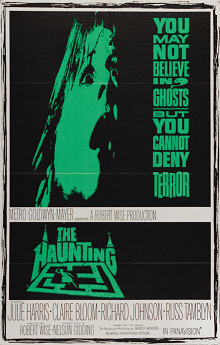"An evil old house, the kind some people call haunted, is like an undiscovered country waiting to be explored. Hill House had stood for 90 years and might stand for 90 more. Silence lay steadily against the wood and stone of Hill House, and whatever walked there ... n g" than the fragile sensitive
"The Haunting" has a power that's truly , for lack of a better word, haunting. With the use of claustrophobia, a distorting 30 MM lens and cleverly designed wallpaper, it is truly a tribute to Robert Wise's first boss, Val Lewton [Head of RKO's Horror Unit]. "We tossed away the horror formula right from the beginning. No grisly stuff for us. No mask-like faces hardly human, with gnashing teeth and hair standing on end. No creaking physical manifestations. No horror piled on horror. You can't keep up horror that's long sustained. It becomes something to laugh at. But take a sweet love story, or a story of sexual antagonisms, about people like us, not freaks, and cut in your horror and there by
Perhaps there's more than the mystifying exterior of Ettington Park Hotel that makes this movie scary. Maybe it's the neither incredibly good or antagonistic cast of characters. . ostracization from her peers throughout the shooting, or the domineering ghostly patriarch Hugh Crain. Maybe, just maybe, it's simply unreliable ambiguity itself taking






No comments:
Post a Comment